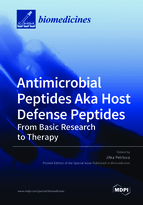Antimicrobial Peptides Aka Host Defense Peptides – from Basic Research to Therapy
A special issue of Biomedicines (ISSN 2227-9059). This special issue belongs to the section "Molecular and Translational Medicine".
Deadline for manuscript submissions: closed (31 May 2022) | Viewed by 26378
Special Issue Editor
Interests: peptide; inflammatory; aggregation; apolipoprotiens; innate immunity; host defense peptides
Special Issues, Collections and Topics in MDPI journals
Special Issue Information
Dear Colleagues,
All wounds are at risk of becoming contaminated by pathogens, which could lead to infection. The ability to effectively overcome this danger is of evolutionary significance to our survival. It is therefore not surprising that multiple host defense systems, such as host defense peptides, have evolved. Antimicrobial peptides, aka host-defense peptides (HDPs), are produced by all living organisms, including bacteria, fungi, plants, invertebrates, and vertebrates. These peptides display activity against bacteria, fungi, viruses, and parasites. Today we have clear evidence that HDPs have far more than broad-spectrum antimicrobial activity, including immunomodulatory effects, wound healing, LPS neutralization, chemotaxis, or anti-cancer effects. Moreover, the multifunctionality of HDPs puts a lot of interest in the development of new therapeutic strategies against infectious diseases.
This Special Issue will address the most current and innovative developments in the field of HDPs research with a range of topics such as structure and function analysis, modes of action, anti-microbial effects, cell and animal model systems, the discovery of novel host defense peptides, and drug development.
Dr. Jitka Petrlova
Guest Editor
Manuscript Submission Information
Manuscripts should be submitted online at www.mdpi.com by registering and logging in to this website. Once you are registered, click here to go to the submission form. Manuscripts can be submitted until the deadline. All submissions that pass pre-check are peer-reviewed. Accepted papers will be published continuously in the journal (as soon as accepted) and will be listed together on the special issue website. Research articles, review articles as well as short communications are invited. For planned papers, a title and short abstract (about 100 words) can be sent to the Editorial Office for announcement on this website.
Submitted manuscripts should not have been published previously, nor be under consideration for publication elsewhere (except conference proceedings papers). All manuscripts are thoroughly refereed through a single-blind peer-review process. A guide for authors and other relevant information for submission of manuscripts is available on the Instructions for Authors page. Biomedicines is an international peer-reviewed open access monthly journal published by MDPI.
Please visit the Instructions for Authors page before submitting a manuscript. The Article Processing Charge (APC) for publication in this open access journal is 2600 CHF (Swiss Francs). Submitted papers should be well formatted and use good English. Authors may use MDPI's English editing service prior to publication or during author revisions.
Keywords
- antimicrobial peptides
- host defense peptides
- innate immunity
- wound healing







